Jennifer Bohnhoff's Blog, page 8
August 21, 2024
Wagons West Under ONE BIG OPEN SKY
Back when I was a kid, if you wanted to read about families going west, you read a book by Laura Ingalls Wilder. Wilder's The Little House on the Prairie series, published between 1932 and 1943, were based on her childhood in a settler and pioneer family. By my childhood in the 1960s, the books were considered classics. They have been continuously in print and have been translated into 40 other languages..
If you look up Best Sellers in Children's 1800 American Historical Fiction on Amazon, chances are you will find Wilder's books high in the rankings. Today when I looked, she held the #1, #4, #5 and #6 places among the top ten: not bad for books that are seventy and eighty years old! Wilder was a runner-up for the Newberry Medal, five five times, and when the American Library Association (ALA) created a lifetime achievement award for children's writers and illustrators in 1954, she was not only the first recipient, but the award was named for her. A screen shot from 8/20/2024 But times change, and with them, tastes and sensibilities in books, and in recent years, the bloom has faded a bit on the Wilder rose. While still popular, critics have pointed out that many of the Little House books include stereotypical and reductive depictions of Native Americans and people of color, and the story they tell is a White story, giving many people the perception that the western expansion was exclusively the story of the dominant culture taking over the land.
A screen shot from 8/20/2024 But times change, and with them, tastes and sensibilities in books, and in recent years, the bloom has faded a bit on the Wilder rose. While still popular, critics have pointed out that many of the Little House books include stereotypical and reductive depictions of Native Americans and people of color, and the story they tell is a White story, giving many people the perception that the western expansion was exclusively the story of the dominant culture taking over the land.
 Lesa Cline-Ransome's new middle grade novel, One Big Open Sky opens up the story of families moving west, making it more inclusive and offering the familiar tale in a way that has long been ignored.
Lesa Cline-Ransome's new middle grade novel, One Big Open Sky opens up the story of families moving west, making it more inclusive and offering the familiar tale in a way that has long been ignored.
In lyrical free verse, it tells the story of Black Americans seeking a better life in the west during post civil war reconstruction.
Ten families take the arduous journey from Mississippi to North Platte, Nebraska seeking acceptance and land of their own. They face dangerous weather, river crossings, threatening mobs, deprivation and death, but their faith and their hope in the future keep them going.
Three characters tell the story. Lettie is a perceptive girl who keeps a log of the journey. She loves her father dearly, despite his faults, which endanger the family. Losing his family when he was a child and a slave has damaged his self worth, and he is continuously trying to prove himself. Her mother, Sylvia, struggles with self determination. Years of being a slave or married to a strong-willed man has left her passive, and she must learn to be strong on this journey. The third voice is that of Philomenia, a strong-willed young woman determined to become a teacher and her own woman after years of living with the knowledge that she was a burden to the aunt and uncle who reluctantly took her in when her parents died.
Because two of the three point of view characters are adult, this story is best for older middle grade readers. It presents serious issues, including enslavement, racism, sexism, and death, and would be excellent for classroom discussion. I think this book is excellent for adult readers, too.
I have one ARC of One Big Open Sky that I would like to give away to another reader now that I have finished with it. If you'd like to be considered, leave a comment.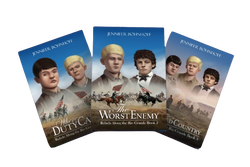 Jennifer Bohnhoff is a former middle school English and Social Studies teacher who now writes historical and contemporary fiction for middle grade and adult readers. The Famished Country, book 3 in the Rebels Along the Rio Grande, will be published by Kinkajou Press in October of 2024 and is now available for preorder.
Jennifer Bohnhoff is a former middle school English and Social Studies teacher who now writes historical and contemporary fiction for middle grade and adult readers. The Famished Country, book 3 in the Rebels Along the Rio Grande, will be published by Kinkajou Press in October of 2024 and is now available for preorder.
If you look up Best Sellers in Children's 1800 American Historical Fiction on Amazon, chances are you will find Wilder's books high in the rankings. Today when I looked, she held the #1, #4, #5 and #6 places among the top ten: not bad for books that are seventy and eighty years old! Wilder was a runner-up for the Newberry Medal, five five times, and when the American Library Association (ALA) created a lifetime achievement award for children's writers and illustrators in 1954, she was not only the first recipient, but the award was named for her.
 A screen shot from 8/20/2024 But times change, and with them, tastes and sensibilities in books, and in recent years, the bloom has faded a bit on the Wilder rose. While still popular, critics have pointed out that many of the Little House books include stereotypical and reductive depictions of Native Americans and people of color, and the story they tell is a White story, giving many people the perception that the western expansion was exclusively the story of the dominant culture taking over the land.
A screen shot from 8/20/2024 But times change, and with them, tastes and sensibilities in books, and in recent years, the bloom has faded a bit on the Wilder rose. While still popular, critics have pointed out that many of the Little House books include stereotypical and reductive depictions of Native Americans and people of color, and the story they tell is a White story, giving many people the perception that the western expansion was exclusively the story of the dominant culture taking over the land.
 Lesa Cline-Ransome's new middle grade novel, One Big Open Sky opens up the story of families moving west, making it more inclusive and offering the familiar tale in a way that has long been ignored.
Lesa Cline-Ransome's new middle grade novel, One Big Open Sky opens up the story of families moving west, making it more inclusive and offering the familiar tale in a way that has long been ignored. In lyrical free verse, it tells the story of Black Americans seeking a better life in the west during post civil war reconstruction.
Ten families take the arduous journey from Mississippi to North Platte, Nebraska seeking acceptance and land of their own. They face dangerous weather, river crossings, threatening mobs, deprivation and death, but their faith and their hope in the future keep them going.
Three characters tell the story. Lettie is a perceptive girl who keeps a log of the journey. She loves her father dearly, despite his faults, which endanger the family. Losing his family when he was a child and a slave has damaged his self worth, and he is continuously trying to prove himself. Her mother, Sylvia, struggles with self determination. Years of being a slave or married to a strong-willed man has left her passive, and she must learn to be strong on this journey. The third voice is that of Philomenia, a strong-willed young woman determined to become a teacher and her own woman after years of living with the knowledge that she was a burden to the aunt and uncle who reluctantly took her in when her parents died.
Because two of the three point of view characters are adult, this story is best for older middle grade readers. It presents serious issues, including enslavement, racism, sexism, and death, and would be excellent for classroom discussion. I think this book is excellent for adult readers, too.
I have one ARC of One Big Open Sky that I would like to give away to another reader now that I have finished with it. If you'd like to be considered, leave a comment.
 Jennifer Bohnhoff is a former middle school English and Social Studies teacher who now writes historical and contemporary fiction for middle grade and adult readers. The Famished Country, book 3 in the Rebels Along the Rio Grande, will be published by Kinkajou Press in October of 2024 and is now available for preorder.
Jennifer Bohnhoff is a former middle school English and Social Studies teacher who now writes historical and contemporary fiction for middle grade and adult readers. The Famished Country, book 3 in the Rebels Along the Rio Grande, will be published by Kinkajou Press in October of 2024 and is now available for preorder.
Published on August 21, 2024 23:00
August 15, 2024
Ovando James Hollister: Witness to History
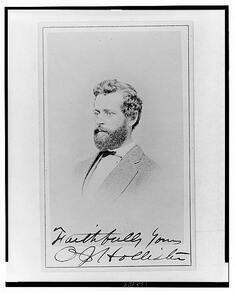 Ovando James Hollister was living in the mining district of South Clear Creek, Colorado, in the summer of 1861 when he heard that fellow miner Sam Cook was looking for volunteers to fill his company.
Ovando James Hollister was living in the mining district of South Clear Creek, Colorado, in the summer of 1861 when he heard that fellow miner Sam Cook was looking for volunteers to fill his company.
Born October 7, 1834 in Colrain, Massachusetts, Hollister, who went by the nickname of "Vando," had very little education as a child. He was raised within a Shaker society in eastern New York, earning his room and board as a farm laborer. Sometime in the 1850s, Hollister moved to Kansas, where he found work on a farm.
 Just imagine living here in the winter! But in July 1858, gold was discovered in the Pike's Peak area of western Kansas Territory and southwestern Nebraska Territory, starting a gold rush that attracted many thousands of hopeful prospectors. By April of 1859, newspaper editors in the major Missouri River towns were reporting that between forty and 100 teams of oxen were going west each day, jamming the roads with their wagons. Hollister joined the rush. He left the Kansas farm and headed west, arriving in the Colorado mining town of Black Hawk on June 7, 1860. The 1860 Territory of Kansas, Arapahoe County (Colorado) Census states that he was living with two other young miners in Missouri City, a mining town southeast of Central City. The next year, he had moved on to South Clear Creek, Colorado.
Just imagine living here in the winter! But in July 1858, gold was discovered in the Pike's Peak area of western Kansas Territory and southwestern Nebraska Territory, starting a gold rush that attracted many thousands of hopeful prospectors. By April of 1859, newspaper editors in the major Missouri River towns were reporting that between forty and 100 teams of oxen were going west each day, jamming the roads with their wagons. Hollister joined the rush. He left the Kansas farm and headed west, arriving in the Colorado mining town of Black Hawk on June 7, 1860. The 1860 Territory of Kansas, Arapahoe County (Colorado) Census states that he was living with two other young miners in Missouri City, a mining town southeast of Central City. The next year, he had moved on to South Clear Creek, Colorado.
 Samuel Cook The life of the prospector was not easy, and few of the young men who arrived in Colorado became rich. Many lived year-round in canvas tents. They cooked over open fires and lived hand to mouth. When fellow miner Samuel H. Cook learned that any man who could bring in a company of volunteers could lead the company, he plastered the area with pamphlets encouraging men to join him. In a very short period, Cook had 80 men. One of them was Hollister.
Samuel Cook The life of the prospector was not easy, and few of the young men who arrived in Colorado became rich. Many lived year-round in canvas tents. They cooked over open fires and lived hand to mouth. When fellow miner Samuel H. Cook learned that any man who could bring in a company of volunteers could lead the company, he plastered the area with pamphlets encouraging men to join him. In a very short period, Cook had 80 men. One of them was Hollister. Cook intended to ride his men to Kansas, where they would serve under General James Lane. Colorado Governor Gilpin had other plans. He convinced Cook and his men that if they stayed in Colorado and joined what was to become Company F of the First Regiment of the Colorado Volunteers, they would be given horses and be well armed and equipped. Cook became the company’s captain. George Nelson, who had shared a tent and gold claim with Cook became one of the company’s lieutenants. Hollister was made sergeant.
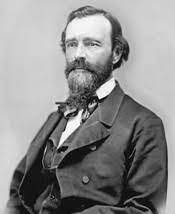 Governor Gilpin As the First Regiment’s ten companies were being formed up, Governor Gilpin was finding its leadership. He appointed John P. Slough, a lawyer who had served in the Ohio Legislature to be the Regiment’s Colonel. Samuel F. Tappan, who later became a journalist and Native American rights activist, was appointed Lt. Colonel. John M. Chivington, a Methodist preacher, was asked to serve as the Regiment’s chaplain, but turned it down, requesting a fighting commission instead. He was appointed Major and nicknamed “The Fighting Parson.”
Governor Gilpin As the First Regiment’s ten companies were being formed up, Governor Gilpin was finding its leadership. He appointed John P. Slough, a lawyer who had served in the Ohio Legislature to be the Regiment’s Colonel. Samuel F. Tappan, who later became a journalist and Native American rights activist, was appointed Lt. Colonel. John M. Chivington, a Methodist preacher, was asked to serve as the Regiment’s chaplain, but turned it down, requesting a fighting commission instead. He was appointed Major and nicknamed “The Fighting Parson.” Because Washington had provided no funding for the formation of troops, Gilpin issued his own script, which paid for uniforms, arms, supplies and equipment for the troops and for the building of Camp Weld, located about two miles from the small town of Denver. On February 14 1862, Major General Hunter ordered all the available forces that Colorado could spare to go south to aid Colonel Canby, the commander of the Department of War in New Mexico. They left on February 22, marching through snowstorms and high winds until they reached Fort Union on March 10th.
Hollister later described the hardships and frustrations of that forced winter march by the Colorado Volunteers. His account makes it clear why Colonel Slough was not beloved of his troops.
The teams, relieved of their loads, took aboard a full complement of passengers, leaving, however, between three and four hundred to foot it. Away into the wee hours of morning did we tramp, tramp, tramp, --the gay song, the gibe, the story, the boisterous cheer, all died a natural death. Nothing broke the stillness of night but the steady tramp of the men and the rattle of the wagons. We were now to prove the sincerity of those patriotic oaths so often sworn, and right nobly was it done. At length the animals began to drop and die in harness, from overwork and underfeed, which forced us to stop. But for this, we would doubtless have made Union without a halt. Col. Slough rode in the coach. That never stops between Red River and Union. Why should we? Thirty miles would not more than measure this night's march, in which the men proved their willingness to put forth every exertion on demand. But feeling as they did, that there was no call for it but the Colonel's caprice, their 'curses were not loud but deep.' During the halt, they hovered over the willow brush fires or shivered under their scanty blankets, nursing their indignation by the most outrageous abuse of everything and everybody. A soldier would grumble in heaven. As it is all the solace they have for their numerous privations and vexations, and is very harmless, let them growl.Hollister left the First Colorado Cavalry in 1863 because of injuries. By that time, he had risen to Colonel. After his time in the Army, Hollister worked as a journalist. He established a newspaper called the Daily Mining Journal in Black Hawk, Colorado. In 1865 he sold his paper and became an associate editor of the Register. By 1868, he was editing the Rocky Mountain News. He was also an author, whose books include: "The Mines of Colorado," "Colorado Volunteers in New Mexico, 1862," "The History of the First Regiment of Colorado Volunteers,." and "Life of Schuyler Colfax," his brother-in-law, who served as Vice President under U.S. Grant. I used several of his books as sources when I was writing the second and third books of Rebels Along the Rio Grande.
At the first sign of daylight "Assembly" sounded as shrilly as if waking to renewed exertion the iron sinews of a steam engine, instead of a weary mass of human energy scarcely composed to rest. But it was none the less inexorable, and satisfying nature with a crust of hard bread, we were on the road again.

 Jennifer Bohnhoff is former New Mexico history teacher who now writes full time. She has recently completed the final book in Rebels Along the Rio Grande, a trilogy of historical novels set in New Mexico during the Civil War. Written for middle grade readers, they are quick and informative books for adult readers as well.
Jennifer Bohnhoff is former New Mexico history teacher who now writes full time. She has recently completed the final book in Rebels Along the Rio Grande, a trilogy of historical novels set in New Mexico during the Civil War. Written for middle grade readers, they are quick and informative books for adult readers as well. Jennifer is an accomplished speaker who loves to present on the history of New Mexico and on other topics to school groups, libraries, and historical societies.
Published on August 15, 2024 16:26
August 9, 2024
Annabel Lee Watkins: A Character in The Famished Country
The Famished Country, book 3 in Rebels Along the Rio Grande, my trilogy of middle grade historical novels set in New Mexico Territory during the American Civil War, comes out this fall. If you've read Where Duty Calls or The Worst Enemy, books 1 and 2, you will know that, while the main characters are fictitious, many of the background and supporting characters are not. I developed my main characters by blending the experiences of several real people, so that my characters could be all the places I wanted them to be, but I set them into a world that was real and filled with real people. Here is an introduction to one of the principal characters and the real and fictious people in her life:  Annabel Lee Watkins is the beautiful teenaged daughter of a Major in the Union Army. Her mother died giving birth to her, and her father has been dragging her from fort to fort her whole life.
Annabel Lee Watkins is the beautiful teenaged daughter of a Major in the Union Army. Her mother died giving birth to her, and her father has been dragging her from fort to fort her whole life.
Annabel's father named her after the last poem Edgar Allen Poe wrote. It was about his great love for a dead woman, and has always made Annabel wonder if her father actually sees her, or the shadow of her dead mother.
Annabel despises the rustic forts of the American West and longs to be sent back east to a finishing school where she will learn the manners and make the connections that will allow her to live a much more refined life. When Colonel Canby, the Commandant of all Union troops in New Mexico Territory learns that a Confederate Force is advancing towards Fort Craig, he sends the fort's women and children north to keep them out of harm's way. Wagons filled with these refugees lumber up the Camino Real, the old Spanish Royal Road that stretched up the Rio Grande. Some of the riders are bound for Fort Union, the great supply depot that guards the final stretches of the Santa Fe Trail, but Annabel's journey ends in Santa Fe.
When Colonel Canby, the Commandant of all Union troops in New Mexico Territory learns that a Confederate Force is advancing towards Fort Craig, he sends the fort's women and children north to keep them out of harm's way. Wagons filled with these refugees lumber up the Camino Real, the old Spanish Royal Road that stretched up the Rio Grande. Some of the riders are bound for Fort Union, the great supply depot that guards the final stretches of the Santa Fe Trail, but Annabel's journey ends in Santa Fe.
 Annabel is the reason that Raul Atencio becomes trapped in Fort Craig in book 1, Where Duty Calls. The nephew of a prominent Socorro merchant, Raul is delivering corn to the fort when he first lays eyes on the girl that he only knows as 'The Major's Golden Daughter.' Smitten with the haughty beauty, Raul finds excuses to visit the fort. On one of those visits, he finds Annabel gone and the Confederates present. He is forced to stay, and ends up participating in the Battle of Valverde as a runner for Kit Carson, the famous mountain man and scout who is leading a group of New Mexico Volunteers.
Annabel is the reason that Raul Atencio becomes trapped in Fort Craig in book 1, Where Duty Calls. The nephew of a prominent Socorro merchant, Raul is delivering corn to the fort when he first lays eyes on the girl that he only knows as 'The Major's Golden Daughter.' Smitten with the haughty beauty, Raul finds excuses to visit the fort. On one of those visits, he finds Annabel gone and the Confederates present. He is forced to stay, and ends up participating in the Battle of Valverde as a runner for Kit Carson, the famous mountain man and scout who is leading a group of New Mexico Volunteers.
 In Santa Fe, Annabel finds shelter in the home of Louisa Canby, the wife of Colonel Canby. Annabel expects life with the officer's wife to be a whirl of balls, teas, and social events, but Mrs. Canby is a practical woman and has turned her home into a hospital for wounded Confederates as a way to keep Santa Fe from being looted.
In Santa Fe, Annabel finds shelter in the home of Louisa Canby, the wife of Colonel Canby. Annabel expects life with the officer's wife to be a whirl of balls, teas, and social events, but Mrs. Canby is a practical woman and has turned her home into a hospital for wounded Confederates as a way to keep Santa Fe from being looted.
Annabel sees Jemmy Martin, a wounded Confederate, as a way out of her circumstances. But Jemmy, and fate, has different plans for her. Annabel Lee
By Edgar Allan Poe It was many and many a year ago,
In a kingdom by the sea,
That a maiden there lived whom you may know
By the name of Annabel Lee;
And this maiden she lived with no other thought
Than to love and be loved by me.
I was a child and she was a child,
In this kingdom by the sea,
But we loved with a love that was more than love—
I and my Annabel Lee—
With a love that the wingèd seraphs of Heaven
Coveted her and me.
And this was the reason that, long ago,
In this kingdom by the sea,
A wind blew out of a cloud, chilling
My beautiful Annabel Lee;
So that her highborn kinsmen came
And bore her away from me,
To shut her up in a sepulchre
In this kingdom by the sea.
The angels, not half so happy in Heaven,
Went envying her and me—
Yes!—that was the reason (as all men know,
In this kingdom by the sea)
That the wind came out of the cloud by night,
Chilling and killing my Annabel Lee.
But our love it was stronger by far than the love
Of those who were older than we—
Of many far wiser than we—
And neither the angels in Heaven above
Nor the demons down under the sea
Can ever dissever my soul from the soul
Of the beautiful Annabel Lee;
For the moon never beams, without bringing me dreams
Of the beautiful Annabel Lee;
And the stars never rise, but I feel the bright eyes
Of the beautiful Annabel Lee;
And so, all the night-tide, I lie down by the side
Of my darling—my darling—my life and my bride,
In her sepulchre there by the sea—
In her tomb by the sounding sea. Jennifer Bohnhoff is a retired teacher who now writes historical and contemporary fiction for middle grade and adult readers.
Jennifer Bohnhoff is a retired teacher who now writes historical and contemporary fiction for middle grade and adult readers.
 Annabel Lee Watkins is the beautiful teenaged daughter of a Major in the Union Army. Her mother died giving birth to her, and her father has been dragging her from fort to fort her whole life.
Annabel Lee Watkins is the beautiful teenaged daughter of a Major in the Union Army. Her mother died giving birth to her, and her father has been dragging her from fort to fort her whole life.Annabel's father named her after the last poem Edgar Allen Poe wrote. It was about his great love for a dead woman, and has always made Annabel wonder if her father actually sees her, or the shadow of her dead mother.
Annabel despises the rustic forts of the American West and longs to be sent back east to a finishing school where she will learn the manners and make the connections that will allow her to live a much more refined life.
 When Colonel Canby, the Commandant of all Union troops in New Mexico Territory learns that a Confederate Force is advancing towards Fort Craig, he sends the fort's women and children north to keep them out of harm's way. Wagons filled with these refugees lumber up the Camino Real, the old Spanish Royal Road that stretched up the Rio Grande. Some of the riders are bound for Fort Union, the great supply depot that guards the final stretches of the Santa Fe Trail, but Annabel's journey ends in Santa Fe.
When Colonel Canby, the Commandant of all Union troops in New Mexico Territory learns that a Confederate Force is advancing towards Fort Craig, he sends the fort's women and children north to keep them out of harm's way. Wagons filled with these refugees lumber up the Camino Real, the old Spanish Royal Road that stretched up the Rio Grande. Some of the riders are bound for Fort Union, the great supply depot that guards the final stretches of the Santa Fe Trail, but Annabel's journey ends in Santa Fe.
 Annabel is the reason that Raul Atencio becomes trapped in Fort Craig in book 1, Where Duty Calls. The nephew of a prominent Socorro merchant, Raul is delivering corn to the fort when he first lays eyes on the girl that he only knows as 'The Major's Golden Daughter.' Smitten with the haughty beauty, Raul finds excuses to visit the fort. On one of those visits, he finds Annabel gone and the Confederates present. He is forced to stay, and ends up participating in the Battle of Valverde as a runner for Kit Carson, the famous mountain man and scout who is leading a group of New Mexico Volunteers.
Annabel is the reason that Raul Atencio becomes trapped in Fort Craig in book 1, Where Duty Calls. The nephew of a prominent Socorro merchant, Raul is delivering corn to the fort when he first lays eyes on the girl that he only knows as 'The Major's Golden Daughter.' Smitten with the haughty beauty, Raul finds excuses to visit the fort. On one of those visits, he finds Annabel gone and the Confederates present. He is forced to stay, and ends up participating in the Battle of Valverde as a runner for Kit Carson, the famous mountain man and scout who is leading a group of New Mexico Volunteers.
 In Santa Fe, Annabel finds shelter in the home of Louisa Canby, the wife of Colonel Canby. Annabel expects life with the officer's wife to be a whirl of balls, teas, and social events, but Mrs. Canby is a practical woman and has turned her home into a hospital for wounded Confederates as a way to keep Santa Fe from being looted.
In Santa Fe, Annabel finds shelter in the home of Louisa Canby, the wife of Colonel Canby. Annabel expects life with the officer's wife to be a whirl of balls, teas, and social events, but Mrs. Canby is a practical woman and has turned her home into a hospital for wounded Confederates as a way to keep Santa Fe from being looted.Annabel sees Jemmy Martin, a wounded Confederate, as a way out of her circumstances. But Jemmy, and fate, has different plans for her. Annabel Lee
By Edgar Allan Poe It was many and many a year ago,
In a kingdom by the sea,
That a maiden there lived whom you may know
By the name of Annabel Lee;
And this maiden she lived with no other thought
Than to love and be loved by me.
I was a child and she was a child,
In this kingdom by the sea,
But we loved with a love that was more than love—
I and my Annabel Lee—
With a love that the wingèd seraphs of Heaven
Coveted her and me.
And this was the reason that, long ago,
In this kingdom by the sea,
A wind blew out of a cloud, chilling
My beautiful Annabel Lee;
So that her highborn kinsmen came
And bore her away from me,
To shut her up in a sepulchre
In this kingdom by the sea.
The angels, not half so happy in Heaven,
Went envying her and me—
Yes!—that was the reason (as all men know,
In this kingdom by the sea)
That the wind came out of the cloud by night,
Chilling and killing my Annabel Lee.
But our love it was stronger by far than the love
Of those who were older than we—
Of many far wiser than we—
And neither the angels in Heaven above
Nor the demons down under the sea
Can ever dissever my soul from the soul
Of the beautiful Annabel Lee;
For the moon never beams, without bringing me dreams
Of the beautiful Annabel Lee;
And the stars never rise, but I feel the bright eyes
Of the beautiful Annabel Lee;
And so, all the night-tide, I lie down by the side
Of my darling—my darling—my life and my bride,
In her sepulchre there by the sea—
In her tomb by the sounding sea.
 Jennifer Bohnhoff is a retired teacher who now writes historical and contemporary fiction for middle grade and adult readers.
Jennifer Bohnhoff is a retired teacher who now writes historical and contemporary fiction for middle grade and adult readers.
Published on August 09, 2024 10:10
August 3, 2024
New Mexican Officer Drain During the Civil War
When the Civil War began, Army officers who had been born in southern states were faced with the question of where their loyalties lay. Of the 1,108 Regular Army officers serving as of 1 January 1861, 270 ultimately resigned to join the South. More than a dozen of those men were serving in the New Mexico Territories at the time.
Legally, army officers had the right to resign their commissions. All they had to do was submit a letter of resignation to the department commander, who forwarded it to the secretary of war for approval by the president. As soon as a letter of acceptance was returned, the officer was free from his obligations to the Union Army. Many men, however, did not wait for the letter, since mail to the territories could take weeks, and they were afraid that Commissions in the new Confederate Army would all be given out if they waited.
Enlisted men had no such chance of leaving the army. They had enlisted for a specified period of time and could not resign. His choice was to wait until his enlistment was up, or desert, a punishable crime if the deserter were apprehended. Because of these regulations, only 26 enlisted men and non-commissioned officers of the regular army are known to have legally left the army at the war’s beginning. By the end of the war, only a few hundred of the 15,135 enlisted men had left the ranks to join the Confederacy.
The high number of resignations in New Mexico Territory left the area in disarray and confusion. Adding to that was the transfer of several companies out of the territory, to fight in the east. Volunteer troops and local militias filled the ranks, but they did not have the experience of working together. Many of the men who left to join the Confederacy had served in New Mexico for long enough to have inspired loyalty in their troops, and that kind of dedication took time to develop. Here is a partial list with ten of the men who left their service in New Mexico to join the Confederacy: Born in Winchester, Virginia in 1796, Thomas Turner Fauntleroy is the only man on this list who did not attend the United States Military Academy at Westpoint. Fauntleroy practiced law and served in the Virginia House of delegates before he commissioned a major of in the dragoons. He served in the Second Seminole War, and was promoted to lieutenant colonel during the Mexican–American War, where he saw action on the Rio Grande and in Mexico City. Now promoted to colonel, Fauntleroy campaigned against Utes in the Rocky Mountains and led expeditions against the Apaches in New Mexico Territory, accompanied by scout Kit Carson. By the beginning of the Civil War, Fauntleroy commanded the Department of New Mexico. Fauntleroy received a commission as brigadier general of the Provisional Army of Virginia. When the Provisional Army of Virginia was merged into the Confederate States Army a month later, Fauntleroy refused to accept a CSA commission, making him the only man on this list who did not serve in the Confederate Army. After he left the Union, the name of Fort Fauntleroy, in western New Mexico, changed to Fort Wingate.
Born in Winchester, Virginia in 1796, Thomas Turner Fauntleroy is the only man on this list who did not attend the United States Military Academy at Westpoint. Fauntleroy practiced law and served in the Virginia House of delegates before he commissioned a major of in the dragoons. He served in the Second Seminole War, and was promoted to lieutenant colonel during the Mexican–American War, where he saw action on the Rio Grande and in Mexico City. Now promoted to colonel, Fauntleroy campaigned against Utes in the Rocky Mountains and led expeditions against the Apaches in New Mexico Territory, accompanied by scout Kit Carson. By the beginning of the Civil War, Fauntleroy commanded the Department of New Mexico. Fauntleroy received a commission as brigadier general of the Provisional Army of Virginia. When the Provisional Army of Virginia was merged into the Confederate States Army a month later, Fauntleroy refused to accept a CSA commission, making him the only man on this list who did not serve in the Confederate Army. After he left the Union, the name of Fort Fauntleroy, in western New Mexico, changed to Fort Wingate.
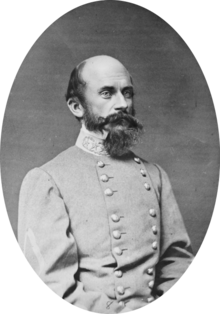 Richard S. Ewell was born in Georgetown, Washington, D.C. and raised at an estate near Manassas known as "Stony Lonesome." He graduated from the United States Military Academy and was commissioned a second lieutenant in the 1st U.S. Dragoons, later being promoted to first lieutenant. Ewell served with Philip St. George Cooke and Stephen Watts Kearny on escort duty along the Santa Fe and Oregon Trails, and under Winfield Scott in the Mexican–American War, where he was promoted to captain. Ewell served in the New Mexico Territory for many years. When the war began, he was in charge of the garrison in Peralta, south of Albuquerque. Paddy Graydon, who served as a Union spy during the New Mexico Campaign, served under Ewell and may have developed some of his eccentric commanding skills because of Ewell. Ewell joined the Provisional Army of Virginia, where he became a colonel. Eventually he was promoted to brigadier general, then major general in the Confederate States Army.
Richard S. Ewell was born in Georgetown, Washington, D.C. and raised at an estate near Manassas known as "Stony Lonesome." He graduated from the United States Military Academy and was commissioned a second lieutenant in the 1st U.S. Dragoons, later being promoted to first lieutenant. Ewell served with Philip St. George Cooke and Stephen Watts Kearny on escort duty along the Santa Fe and Oregon Trails, and under Winfield Scott in the Mexican–American War, where he was promoted to captain. Ewell served in the New Mexico Territory for many years. When the war began, he was in charge of the garrison in Peralta, south of Albuquerque. Paddy Graydon, who served as a Union spy during the New Mexico Campaign, served under Ewell and may have developed some of his eccentric commanding skills because of Ewell. Ewell joined the Provisional Army of Virginia, where he became a colonel. Eventually he was promoted to brigadier general, then major general in the Confederate States Army.
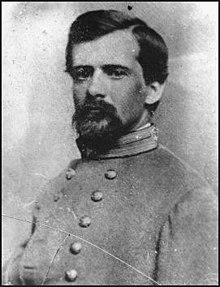 John Pegram was born in Petersburg, Virginia in 1832. His class at the United States Military Academy included future generals J.E.B. Stuart, Stephen D. Lee and Oliver O. Howard. Pegram was commissioned as a second lieutenant in the dragoons and served at a variety of garrisons and outposts in the West before becoming an Assistant Instructor of Cavalry at West Point. He spent two years in Europe observing the Austro-Sardinian War before being assigned to duty in the New Mexico Territory. When the war began, Pegram resigned his lieutenant's commission and returned home, where he accepted a commission as a lieutenant colonel and was assigned command of the 20th Virginia Infantry. John Pegram became the first former U.S. Army officer to be captured while in Confederate service when he surrendered his entire regiment to the Federals during the Battle of Rich Mountain on July 11, 1861. He spent six months imprisoned in Fort Warren in Boston harbor. When he was released in a POW exchange, he was promoted to colonel and became the Chief Engineer of the army of General Pierre G. T. Beauregard. He was promoted to brigadier general. Pegram was killed in action during the Battle of Hatcher's Run.
John Pegram was born in Petersburg, Virginia in 1832. His class at the United States Military Academy included future generals J.E.B. Stuart, Stephen D. Lee and Oliver O. Howard. Pegram was commissioned as a second lieutenant in the dragoons and served at a variety of garrisons and outposts in the West before becoming an Assistant Instructor of Cavalry at West Point. He spent two years in Europe observing the Austro-Sardinian War before being assigned to duty in the New Mexico Territory. When the war began, Pegram resigned his lieutenant's commission and returned home, where he accepted a commission as a lieutenant colonel and was assigned command of the 20th Virginia Infantry. John Pegram became the first former U.S. Army officer to be captured while in Confederate service when he surrendered his entire regiment to the Federals during the Battle of Rich Mountain on July 11, 1861. He spent six months imprisoned in Fort Warren in Boston harbor. When he was released in a POW exchange, he was promoted to colonel and became the Chief Engineer of the army of General Pierre G. T. Beauregard. He was promoted to brigadier general. Pegram was killed in action during the Battle of Hatcher's Run.
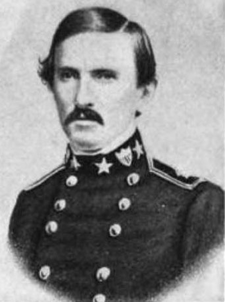 George B. Crittenden was born in 1812 in Russellville, Kentucky. He graduated from the United States Military Academy in 1832 and was commissioned a second lieutenant in the 4th U.S. Infantry. He fought in the Black Hawk War of 1832, and resigned his commission and joined the Army of the Republic of Texas. In 1846 he rejoined the U.S. Army and fought with the Regiment of Mounted Rifles in the Mexican–American War, where he received a brevet promotion for gallantry. By 1856, he’d become lieutenant colonel and was stationed in New Mexico. Crittenden accepted a commission as colonel in the Confederate Army, was promoted to brigadier general and then major general, but after being arrested on charges of drunkenness he went back to being a colonel.
George B. Crittenden was born in 1812 in Russellville, Kentucky. He graduated from the United States Military Academy in 1832 and was commissioned a second lieutenant in the 4th U.S. Infantry. He fought in the Black Hawk War of 1832, and resigned his commission and joined the Army of the Republic of Texas. In 1846 he rejoined the U.S. Army and fought with the Regiment of Mounted Rifles in the Mexican–American War, where he received a brevet promotion for gallantry. By 1856, he’d become lieutenant colonel and was stationed in New Mexico. Crittenden accepted a commission as colonel in the Confederate Army, was promoted to brigadier general and then major general, but after being arrested on charges of drunkenness he went back to being a colonel.
 Laurence Simmons Baker was born in 1830 in Gates County, North Carolina. He graduated from the United States Military Academy at West Point and was breveted a second. He served for nine years in the U.S. Mounted Rifles, assigned to duty on the western frontier and rising to the rank of first lieutenant. He was serving in the 2nd Dragoons and stationed at Fort Union when the war broke out. He became the lieutenant colonel of the 1st North Carolina Cavalry Regiment, and was then promoted to colonel and then brigadier general.
Laurence Simmons Baker was born in 1830 in Gates County, North Carolina. He graduated from the United States Military Academy at West Point and was breveted a second. He served for nine years in the U.S. Mounted Rifles, assigned to duty on the western frontier and rising to the rank of first lieutenant. He was serving in the 2nd Dragoons and stationed at Fort Union when the war broke out. He became the lieutenant colonel of the 1st North Carolina Cavalry Regiment, and was then promoted to colonel and then brigadier general.
Henry C. McNeill was a Second Lieutenant in the Second Dragoons, stationed at Fort Union when the Civil War began. Born in 1833, in Natchez, Mississippi and graduated from the United States Military Academy at West Point. McNeill was commissioned as lieutenant colonel in the Fifth Texas Cavalry, which entered New Mexico as part of Sibley’s Army of New Mexico. He was later promoted to colonel.
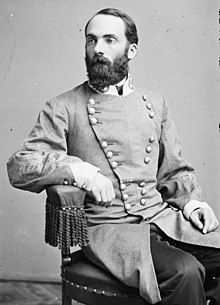 “Fighting Joe” Joseph Wheeler got his nickname while fighting Indians the New Mexico Territory with the Regiment of Mounted Rifles. Born in Augusta, Georgia in 1836, he had attended the United States Military Academy at West Point and had been promoted to second lieutenant when the Civil War broke out. He became a first lieutenant in the Georgia state militia artillery and then was promoted to colonel, in command of the newly formed 19th Alabama Infantry Regiment. He later became a major general. He later served in the U.S. army again, in the Spanish American War and in the Philippines, and is one of the few Confederate officers buried in Arlington Cemetery.
“Fighting Joe” Joseph Wheeler got his nickname while fighting Indians the New Mexico Territory with the Regiment of Mounted Rifles. Born in Augusta, Georgia in 1836, he had attended the United States Military Academy at West Point and had been promoted to second lieutenant when the Civil War broke out. He became a first lieutenant in the Georgia state militia artillery and then was promoted to colonel, in command of the newly formed 19th Alabama Infantry Regiment. He later became a major general. He later served in the U.S. army again, in the Spanish American War and in the Philippines, and is one of the few Confederate officers buried in Arlington Cemetery.
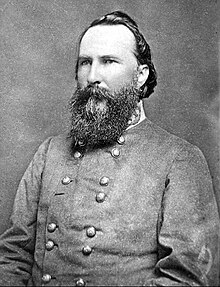 Lucius Loomis Rich was born September 1831 in Liberty, Missouri. He graduated from the United States Military Academy at West Point and was commissioned 2nd Lieutenant in the 5th Infantry Regiment. He was promoted to 1st Lieutenant six years later. He was stationed in New Mexico with the Fifth Infantry when the Civil War began and he resigned his commission. He was given command as Colonel of the 1st Missouri Infantry, CSA, and died as a result of wounds received at the battle of Shiloh, April 6, 1862
Lucius Loomis Rich was born September 1831 in Liberty, Missouri. He graduated from the United States Military Academy at West Point and was commissioned 2nd Lieutenant in the 5th Infantry Regiment. He was promoted to 1st Lieutenant six years later. He was stationed in New Mexico with the Fifth Infantry when the Civil War began and he resigned his commission. He was given command as Colonel of the 1st Missouri Infantry, CSA, and died as a result of wounds received at the battle of Shiloh, April 6, 1862
James Longstreet was born in Edgefield District, South Carolina in 1821. He the United States Military Academy at West Point, Longstreet and was commissioned a brevet second lieutenant. He served in the United States Army during the Mexican–American War, then became an Army recruiter in Poughkeepsie, New York, served at Carlisle Barracks in Pennsylvania, and was Chief Commissary for the Department of Texas, responsible for acquiring and distributing food to the department's soldiers and animals. Longstreet served on frontier duty in Texas at Fort Martin Scott near Fredericksburg, then was transferred to Fort Bliss in El Paso. After that, he became major and paymaster for the 8th Infantry in Leavenworth, Kansas. Longstreet was in Albuquerque, New Mexico, serving as paymaster for the department when the Civil War broke out. He resigned his commission and accepted a commission as a lieutenant colonel in the Confederate States Army. Within a month he had become a brigadier general.
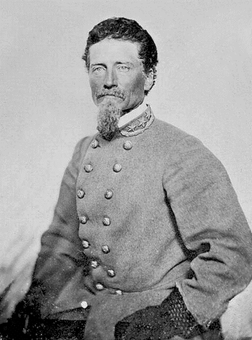 Dabney Herndon Maury had been born in Fredericksburg, Virginia in 1822. He studied law and graduated from the University of Virginia in the class of 1841 and then finished his studies at Westpoint, the United States Military Academy. In 1846 he was brevetted as a second lieutenant in the Regiment of Mounted Rifles, in which he served during the Mexican–American War. After that, he taught at West Point, then in the Oregon Territory and on the Texas frontier before commanding the Cavalry School at the Carlisle Barracks. When the Civil War broke out, Maury was the Assistant Adjutant General in the New Mexico Territory, based in Santa Fe. He resigned from the United States Army and travelled back to Virginia, where he entered the Confederate Army as a colonel. After the Battle of Pea Ridge, he was promoted to the rank of brigadier general.
Dabney Herndon Maury had been born in Fredericksburg, Virginia in 1822. He studied law and graduated from the University of Virginia in the class of 1841 and then finished his studies at Westpoint, the United States Military Academy. In 1846 he was brevetted as a second lieutenant in the Regiment of Mounted Rifles, in which he served during the Mexican–American War. After that, he taught at West Point, then in the Oregon Territory and on the Texas frontier before commanding the Cavalry School at the Carlisle Barracks. When the Civil War broke out, Maury was the Assistant Adjutant General in the New Mexico Territory, based in Santa Fe. He resigned from the United States Army and travelled back to Virginia, where he entered the Confederate Army as a colonel. After the Battle of Pea Ridge, he was promoted to the rank of brigadier general.
Two men not included on this list, since I have written about them before, are H. H. Sibley and William Loring, both of whom were also West Point grads who went on to become generals in the Confederate Army. New Mexico was just a territory at the time of the Civil War, but it held a large number of soldiers because of the Apaches, Navajos and Comanches that threatened settlements and travel on the Santa Fe trail. Many of these men had served primarily on raids against the Indians. Most had gone to West Point. The older men had served in the Mexican American War. When they resigned, they left a power vacuum that was filled by Richard Canby, a capable administrator but cautious battle leader, who looked to native New Mexicans and Coloradans to fill the void. Jennifer Bohnhoff is a former educator who has published a trilogy of historical fiction novels set in New Mexico during the Civil War. Rebels Along the Rio Grande is written for middle grade readers, but enjoyed by adults as a quick and informative introduction to a period that is largely unknown by the reading public.
Jennifer Bohnhoff is a former educator who has published a trilogy of historical fiction novels set in New Mexico during the Civil War. Rebels Along the Rio Grande is written for middle grade readers, but enjoyed by adults as a quick and informative introduction to a period that is largely unknown by the reading public.
Legally, army officers had the right to resign their commissions. All they had to do was submit a letter of resignation to the department commander, who forwarded it to the secretary of war for approval by the president. As soon as a letter of acceptance was returned, the officer was free from his obligations to the Union Army. Many men, however, did not wait for the letter, since mail to the territories could take weeks, and they were afraid that Commissions in the new Confederate Army would all be given out if they waited.
Enlisted men had no such chance of leaving the army. They had enlisted for a specified period of time and could not resign. His choice was to wait until his enlistment was up, or desert, a punishable crime if the deserter were apprehended. Because of these regulations, only 26 enlisted men and non-commissioned officers of the regular army are known to have legally left the army at the war’s beginning. By the end of the war, only a few hundred of the 15,135 enlisted men had left the ranks to join the Confederacy.
The high number of resignations in New Mexico Territory left the area in disarray and confusion. Adding to that was the transfer of several companies out of the territory, to fight in the east. Volunteer troops and local militias filled the ranks, but they did not have the experience of working together. Many of the men who left to join the Confederacy had served in New Mexico for long enough to have inspired loyalty in their troops, and that kind of dedication took time to develop. Here is a partial list with ten of the men who left their service in New Mexico to join the Confederacy:
 Born in Winchester, Virginia in 1796, Thomas Turner Fauntleroy is the only man on this list who did not attend the United States Military Academy at Westpoint. Fauntleroy practiced law and served in the Virginia House of delegates before he commissioned a major of in the dragoons. He served in the Second Seminole War, and was promoted to lieutenant colonel during the Mexican–American War, where he saw action on the Rio Grande and in Mexico City. Now promoted to colonel, Fauntleroy campaigned against Utes in the Rocky Mountains and led expeditions against the Apaches in New Mexico Territory, accompanied by scout Kit Carson. By the beginning of the Civil War, Fauntleroy commanded the Department of New Mexico. Fauntleroy received a commission as brigadier general of the Provisional Army of Virginia. When the Provisional Army of Virginia was merged into the Confederate States Army a month later, Fauntleroy refused to accept a CSA commission, making him the only man on this list who did not serve in the Confederate Army. After he left the Union, the name of Fort Fauntleroy, in western New Mexico, changed to Fort Wingate.
Born in Winchester, Virginia in 1796, Thomas Turner Fauntleroy is the only man on this list who did not attend the United States Military Academy at Westpoint. Fauntleroy practiced law and served in the Virginia House of delegates before he commissioned a major of in the dragoons. He served in the Second Seminole War, and was promoted to lieutenant colonel during the Mexican–American War, where he saw action on the Rio Grande and in Mexico City. Now promoted to colonel, Fauntleroy campaigned against Utes in the Rocky Mountains and led expeditions against the Apaches in New Mexico Territory, accompanied by scout Kit Carson. By the beginning of the Civil War, Fauntleroy commanded the Department of New Mexico. Fauntleroy received a commission as brigadier general of the Provisional Army of Virginia. When the Provisional Army of Virginia was merged into the Confederate States Army a month later, Fauntleroy refused to accept a CSA commission, making him the only man on this list who did not serve in the Confederate Army. After he left the Union, the name of Fort Fauntleroy, in western New Mexico, changed to Fort Wingate. Richard S. Ewell was born in Georgetown, Washington, D.C. and raised at an estate near Manassas known as "Stony Lonesome." He graduated from the United States Military Academy and was commissioned a second lieutenant in the 1st U.S. Dragoons, later being promoted to first lieutenant. Ewell served with Philip St. George Cooke and Stephen Watts Kearny on escort duty along the Santa Fe and Oregon Trails, and under Winfield Scott in the Mexican–American War, where he was promoted to captain. Ewell served in the New Mexico Territory for many years. When the war began, he was in charge of the garrison in Peralta, south of Albuquerque. Paddy Graydon, who served as a Union spy during the New Mexico Campaign, served under Ewell and may have developed some of his eccentric commanding skills because of Ewell. Ewell joined the Provisional Army of Virginia, where he became a colonel. Eventually he was promoted to brigadier general, then major general in the Confederate States Army.
Richard S. Ewell was born in Georgetown, Washington, D.C. and raised at an estate near Manassas known as "Stony Lonesome." He graduated from the United States Military Academy and was commissioned a second lieutenant in the 1st U.S. Dragoons, later being promoted to first lieutenant. Ewell served with Philip St. George Cooke and Stephen Watts Kearny on escort duty along the Santa Fe and Oregon Trails, and under Winfield Scott in the Mexican–American War, where he was promoted to captain. Ewell served in the New Mexico Territory for many years. When the war began, he was in charge of the garrison in Peralta, south of Albuquerque. Paddy Graydon, who served as a Union spy during the New Mexico Campaign, served under Ewell and may have developed some of his eccentric commanding skills because of Ewell. Ewell joined the Provisional Army of Virginia, where he became a colonel. Eventually he was promoted to brigadier general, then major general in the Confederate States Army.
 John Pegram was born in Petersburg, Virginia in 1832. His class at the United States Military Academy included future generals J.E.B. Stuart, Stephen D. Lee and Oliver O. Howard. Pegram was commissioned as a second lieutenant in the dragoons and served at a variety of garrisons and outposts in the West before becoming an Assistant Instructor of Cavalry at West Point. He spent two years in Europe observing the Austro-Sardinian War before being assigned to duty in the New Mexico Territory. When the war began, Pegram resigned his lieutenant's commission and returned home, where he accepted a commission as a lieutenant colonel and was assigned command of the 20th Virginia Infantry. John Pegram became the first former U.S. Army officer to be captured while in Confederate service when he surrendered his entire regiment to the Federals during the Battle of Rich Mountain on July 11, 1861. He spent six months imprisoned in Fort Warren in Boston harbor. When he was released in a POW exchange, he was promoted to colonel and became the Chief Engineer of the army of General Pierre G. T. Beauregard. He was promoted to brigadier general. Pegram was killed in action during the Battle of Hatcher's Run.
John Pegram was born in Petersburg, Virginia in 1832. His class at the United States Military Academy included future generals J.E.B. Stuart, Stephen D. Lee and Oliver O. Howard. Pegram was commissioned as a second lieutenant in the dragoons and served at a variety of garrisons and outposts in the West before becoming an Assistant Instructor of Cavalry at West Point. He spent two years in Europe observing the Austro-Sardinian War before being assigned to duty in the New Mexico Territory. When the war began, Pegram resigned his lieutenant's commission and returned home, where he accepted a commission as a lieutenant colonel and was assigned command of the 20th Virginia Infantry. John Pegram became the first former U.S. Army officer to be captured while in Confederate service when he surrendered his entire regiment to the Federals during the Battle of Rich Mountain on July 11, 1861. He spent six months imprisoned in Fort Warren in Boston harbor. When he was released in a POW exchange, he was promoted to colonel and became the Chief Engineer of the army of General Pierre G. T. Beauregard. He was promoted to brigadier general. Pegram was killed in action during the Battle of Hatcher's Run. George B. Crittenden was born in 1812 in Russellville, Kentucky. He graduated from the United States Military Academy in 1832 and was commissioned a second lieutenant in the 4th U.S. Infantry. He fought in the Black Hawk War of 1832, and resigned his commission and joined the Army of the Republic of Texas. In 1846 he rejoined the U.S. Army and fought with the Regiment of Mounted Rifles in the Mexican–American War, where he received a brevet promotion for gallantry. By 1856, he’d become lieutenant colonel and was stationed in New Mexico. Crittenden accepted a commission as colonel in the Confederate Army, was promoted to brigadier general and then major general, but after being arrested on charges of drunkenness he went back to being a colonel.
George B. Crittenden was born in 1812 in Russellville, Kentucky. He graduated from the United States Military Academy in 1832 and was commissioned a second lieutenant in the 4th U.S. Infantry. He fought in the Black Hawk War of 1832, and resigned his commission and joined the Army of the Republic of Texas. In 1846 he rejoined the U.S. Army and fought with the Regiment of Mounted Rifles in the Mexican–American War, where he received a brevet promotion for gallantry. By 1856, he’d become lieutenant colonel and was stationed in New Mexico. Crittenden accepted a commission as colonel in the Confederate Army, was promoted to brigadier general and then major general, but after being arrested on charges of drunkenness he went back to being a colonel.  Laurence Simmons Baker was born in 1830 in Gates County, North Carolina. He graduated from the United States Military Academy at West Point and was breveted a second. He served for nine years in the U.S. Mounted Rifles, assigned to duty on the western frontier and rising to the rank of first lieutenant. He was serving in the 2nd Dragoons and stationed at Fort Union when the war broke out. He became the lieutenant colonel of the 1st North Carolina Cavalry Regiment, and was then promoted to colonel and then brigadier general.
Laurence Simmons Baker was born in 1830 in Gates County, North Carolina. He graduated from the United States Military Academy at West Point and was breveted a second. He served for nine years in the U.S. Mounted Rifles, assigned to duty on the western frontier and rising to the rank of first lieutenant. He was serving in the 2nd Dragoons and stationed at Fort Union when the war broke out. He became the lieutenant colonel of the 1st North Carolina Cavalry Regiment, and was then promoted to colonel and then brigadier general.Henry C. McNeill was a Second Lieutenant in the Second Dragoons, stationed at Fort Union when the Civil War began. Born in 1833, in Natchez, Mississippi and graduated from the United States Military Academy at West Point. McNeill was commissioned as lieutenant colonel in the Fifth Texas Cavalry, which entered New Mexico as part of Sibley’s Army of New Mexico. He was later promoted to colonel.
 “Fighting Joe” Joseph Wheeler got his nickname while fighting Indians the New Mexico Territory with the Regiment of Mounted Rifles. Born in Augusta, Georgia in 1836, he had attended the United States Military Academy at West Point and had been promoted to second lieutenant when the Civil War broke out. He became a first lieutenant in the Georgia state militia artillery and then was promoted to colonel, in command of the newly formed 19th Alabama Infantry Regiment. He later became a major general. He later served in the U.S. army again, in the Spanish American War and in the Philippines, and is one of the few Confederate officers buried in Arlington Cemetery.
“Fighting Joe” Joseph Wheeler got his nickname while fighting Indians the New Mexico Territory with the Regiment of Mounted Rifles. Born in Augusta, Georgia in 1836, he had attended the United States Military Academy at West Point and had been promoted to second lieutenant when the Civil War broke out. He became a first lieutenant in the Georgia state militia artillery and then was promoted to colonel, in command of the newly formed 19th Alabama Infantry Regiment. He later became a major general. He later served in the U.S. army again, in the Spanish American War and in the Philippines, and is one of the few Confederate officers buried in Arlington Cemetery. Lucius Loomis Rich was born September 1831 in Liberty, Missouri. He graduated from the United States Military Academy at West Point and was commissioned 2nd Lieutenant in the 5th Infantry Regiment. He was promoted to 1st Lieutenant six years later. He was stationed in New Mexico with the Fifth Infantry when the Civil War began and he resigned his commission. He was given command as Colonel of the 1st Missouri Infantry, CSA, and died as a result of wounds received at the battle of Shiloh, April 6, 1862
Lucius Loomis Rich was born September 1831 in Liberty, Missouri. He graduated from the United States Military Academy at West Point and was commissioned 2nd Lieutenant in the 5th Infantry Regiment. He was promoted to 1st Lieutenant six years later. He was stationed in New Mexico with the Fifth Infantry when the Civil War began and he resigned his commission. He was given command as Colonel of the 1st Missouri Infantry, CSA, and died as a result of wounds received at the battle of Shiloh, April 6, 1862James Longstreet was born in Edgefield District, South Carolina in 1821. He the United States Military Academy at West Point, Longstreet and was commissioned a brevet second lieutenant. He served in the United States Army during the Mexican–American War, then became an Army recruiter in Poughkeepsie, New York, served at Carlisle Barracks in Pennsylvania, and was Chief Commissary for the Department of Texas, responsible for acquiring and distributing food to the department's soldiers and animals. Longstreet served on frontier duty in Texas at Fort Martin Scott near Fredericksburg, then was transferred to Fort Bliss in El Paso. After that, he became major and paymaster for the 8th Infantry in Leavenworth, Kansas. Longstreet was in Albuquerque, New Mexico, serving as paymaster for the department when the Civil War broke out. He resigned his commission and accepted a commission as a lieutenant colonel in the Confederate States Army. Within a month he had become a brigadier general.
 Dabney Herndon Maury had been born in Fredericksburg, Virginia in 1822. He studied law and graduated from the University of Virginia in the class of 1841 and then finished his studies at Westpoint, the United States Military Academy. In 1846 he was brevetted as a second lieutenant in the Regiment of Mounted Rifles, in which he served during the Mexican–American War. After that, he taught at West Point, then in the Oregon Territory and on the Texas frontier before commanding the Cavalry School at the Carlisle Barracks. When the Civil War broke out, Maury was the Assistant Adjutant General in the New Mexico Territory, based in Santa Fe. He resigned from the United States Army and travelled back to Virginia, where he entered the Confederate Army as a colonel. After the Battle of Pea Ridge, he was promoted to the rank of brigadier general.
Dabney Herndon Maury had been born in Fredericksburg, Virginia in 1822. He studied law and graduated from the University of Virginia in the class of 1841 and then finished his studies at Westpoint, the United States Military Academy. In 1846 he was brevetted as a second lieutenant in the Regiment of Mounted Rifles, in which he served during the Mexican–American War. After that, he taught at West Point, then in the Oregon Territory and on the Texas frontier before commanding the Cavalry School at the Carlisle Barracks. When the Civil War broke out, Maury was the Assistant Adjutant General in the New Mexico Territory, based in Santa Fe. He resigned from the United States Army and travelled back to Virginia, where he entered the Confederate Army as a colonel. After the Battle of Pea Ridge, he was promoted to the rank of brigadier general.Two men not included on this list, since I have written about them before, are H. H. Sibley and William Loring, both of whom were also West Point grads who went on to become generals in the Confederate Army. New Mexico was just a territory at the time of the Civil War, but it held a large number of soldiers because of the Apaches, Navajos and Comanches that threatened settlements and travel on the Santa Fe trail. Many of these men had served primarily on raids against the Indians. Most had gone to West Point. The older men had served in the Mexican American War. When they resigned, they left a power vacuum that was filled by Richard Canby, a capable administrator but cautious battle leader, who looked to native New Mexicans and Coloradans to fill the void.
 Jennifer Bohnhoff is a former educator who has published a trilogy of historical fiction novels set in New Mexico during the Civil War. Rebels Along the Rio Grande is written for middle grade readers, but enjoyed by adults as a quick and informative introduction to a period that is largely unknown by the reading public.
Jennifer Bohnhoff is a former educator who has published a trilogy of historical fiction novels set in New Mexico during the Civil War. Rebels Along the Rio Grande is written for middle grade readers, but enjoyed by adults as a quick and informative introduction to a period that is largely unknown by the reading public.
Published on August 03, 2024 08:54
July 17, 2024
Finis Ewing Kavanaugh and the Battle for Cubero
 Cubero in the 1860s, Palace of the Governors Photo Archives, NMHM/DCA, 15757 Cubero is a tiny town with a big Civil War story about a battle that was won without a single shot being fired, by a small but determined group of men against a garrison ten times its size. Located just north of I-40 between Laguna Pueblo and Grants, 45 miles west of Albuquerque, the town has less than 300 people today. It has a post office and an elementary school, but not much else.
Cubero in the 1860s, Palace of the Governors Photo Archives, NMHM/DCA, 15757 Cubero is a tiny town with a big Civil War story about a battle that was won without a single shot being fired, by a small but determined group of men against a garrison ten times its size. Located just north of I-40 between Laguna Pueblo and Grants, 45 miles west of Albuquerque, the town has less than 300 people today. It has a post office and an elementary school, but not much else.At the time of the Civil War, Cubero was a small farming community.Cubero and nearby San Fidel provided hay for the horses stabled at Fort Wingate. It also housed a depot that the Army kept there to keep its soldiers supplied during its intermittent campaigns against the Navajo. The depot, and the trail to Fort Wingate, were guarded by 45 soldiers who were Volunteers in the New Mexico militia.
 Sutlers sold extra food and supplies to soldiers. Their stores were often in tents so they could move with the army. One of Cubero’s most prominent citizens was Finis Ewing Kavanaugh (some records spell his name with a C). Born in 1833, in Lafayette, Missouri, Kavanaugh attended St. Louis Medical College before establishing a practice in Santa Fe. During the 1850s he served as physician on several of the Army’s Indian campaigns and was part of the expedition into Utah during the Mormon War.
Sutlers sold extra food and supplies to soldiers. Their stores were often in tents so they could move with the army. One of Cubero’s most prominent citizens was Finis Ewing Kavanaugh (some records spell his name with a C). Born in 1833, in Lafayette, Missouri, Kavanaugh attended St. Louis Medical College before establishing a practice in Santa Fe. During the 1850s he served as physician on several of the Army’s Indian campaigns and was part of the expedition into Utah during the Mormon War. In 1858, he became co-owner of a sutler’s store, a store that provided goods to soldiers, at Camp Floyd. He also owned the post sutleries at Cubero and Fort Fauntleroy, which changed its name to Lyon, and finally Wingate after Colonel Thomas Turner Fauntleroy left the Union Army to assume a position as brigadier general in the Provisional Army of Virginia. Kavanaugh owned and raced fine horses and served in the territorial legislature. His wife (who may have been common-law), Refugio Aguilar stayed on Kavanaugh’s ranch near Cubero. They had at least 2, and possibly 5 children.
 Bill Davidson Although he had served in the U.S. Army, Kavanaugh was a Confederate sympathizer. When he learned that Confederate Brigadier General H. H. Sibley was leading his Army of New Mexico up the Rio Grande, he hatched a plot to provide the Rebels with supplies. Accompanied by three fellow conspirators, George Gardenhier, R.T. Thompson, and Richmond (sometimes called Richard, or Dick) Gillespie, Kavanaugh confronted Francisco Aragon, the captain of the post at Cubero. They convinced the captain that they were the vanguard of a mighty Army, which was bearing down on the post, and that it would be wise of the captain to surrender.
Bill Davidson Although he had served in the U.S. Army, Kavanaugh was a Confederate sympathizer. When he learned that Confederate Brigadier General H. H. Sibley was leading his Army of New Mexico up the Rio Grande, he hatched a plot to provide the Rebels with supplies. Accompanied by three fellow conspirators, George Gardenhier, R.T. Thompson, and Richmond (sometimes called Richard, or Dick) Gillespie, Kavanaugh confronted Francisco Aragon, the captain of the post at Cubero. They convinced the captain that they were the vanguard of a mighty Army, which was bearing down on the post, and that it would be wise of the captain to surrender.Bill Davidson, a soldier in Sibley’s Army later wrote that, immediately after the battle of Valverde, General Canby had sent a courier to Cubero warning them of the Confederate approach, but the Indians had killed the courier. Whether or not this is true, Aragon was caught completely off guard, and quickly surrendered. the Battle of Cubero was won without a single shot being fired: four Confederates had managed to overwhelm a 45 man garrison with words alone.
Gillespie then rode to Albuquerque, where he got Captain A. S. Thurmond and Company A of the 3rd Texas Mounted Volunteers to return with him to Cubero to retrieve the captured supplies. They were able to bring between 20 and 25 wagon-loads of military supplies including 60 guns and 3,000 rounds of ammunition back to Albuquerque. Some of the Confederate soldiers who arrived at Cubero were sick and ended up staying at the abandoned post, where they lived off supplies from Kavenaugh’s store. Three of those soldiers died, probably of pneumonia, and are buried in Cubero’s cemetery.
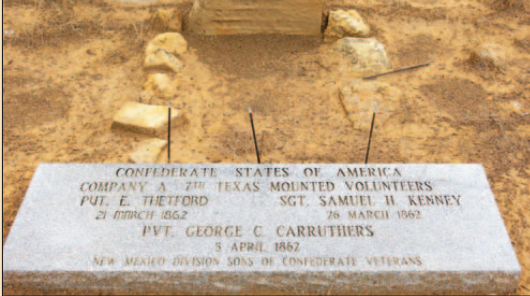 Kathy Helms/Independent https://www.ftwingate.org/docs/pub/ Correspondence/Aug_10_2017_A_Piece_of_Civil_war_history_lies_in_Cubero_Cemetery.pdf When Kavanaugh and his accomplices were indicted for treason, he headed for Texas, where he was commissioned as a Major in Baird's 4th Texas Cavalry. Kavanaugh's property was confiscated by the U.S. Army and sold for $1,657.28. I could find nothing explaining what happened to his wife and children, which it seems he abandoned when he left the territory. In Texas, he became friends with Colonel Dan Showalter.
Kathy Helms/Independent https://www.ftwingate.org/docs/pub/ Correspondence/Aug_10_2017_A_Piece_of_Civil_war_history_lies_in_Cubero_Cemetery.pdf When Kavanaugh and his accomplices were indicted for treason, he headed for Texas, where he was commissioned as a Major in Baird's 4th Texas Cavalry. Kavanaugh's property was confiscated by the U.S. Army and sold for $1,657.28. I could find nothing explaining what happened to his wife and children, which it seems he abandoned when he left the territory. In Texas, he became friends with Colonel Dan Showalter.After the war, Dr. Kavanaugh went south to Mexico, where he and Showalter opened a bar in Mazatlan. Showalter was shot and killed in a bar fight in February 1866. Some records state that Kavanaugh died in that same fight, while others report that he died of alcoholism and tuberculosis. He was 33 years old when he was buried in the U.S. National Cemetery in Mexico City. Jennifer Bohnhoff is the author of Rebels Along the Rio Grande, a trilogy of middle grade novels set in New Mexico during the Civil War. The Cubero incident described above happened during the time covered in The Worst Enemy, book 2 of the series. Book 3 will be published in October 2024.

Published on July 17, 2024 23:00
July 11, 2024
Chocolate Peanut Butter Granola
It's summer, and just too darn hot to cook, even first thing in the morning.
You will have to turn your oven on to make a batch of this yummy granola, but it'll be worth it! Slice a banana or strawberries over the top and serve with milk for a sweet way to start your day.
But this is too good to be just for breakfast. Sprinkle it over ice cream for an easy dessert. If you're really feeling creative, pack some of it into a pie plate when it is fresh from the over and the chocolate hasn't yet set up, and you'll have a super crust for an ice cream pie.
 Chocolate Peanut Butter Granola Preheat oven to 325°
Chocolate Peanut Butter Granola Preheat oven to 325°
Spray a roasting pan with oil.
Place in roasting pan and mix:
3 cups regular rolled oats
1 cup roasted peanuts, chopped very coarsely
3/4 cup chocolate chips
1/2 cup sunflower seeds
1 tsp ground cinnamon
Mix in microwave-safe bowl. Microwave 30 seconds, then stir. Repeat until peanut butter is liquid and mixture is smooth:
1/2 cup smooth peanut butter
1/2 cup light karo syrup
1/4 cup brown sugar
2 TBS water
Pour the peanut butter mixture over the dry ingredients and mix well. Spread in an even layer.
Bake for 24 minutes, taking out every 8 minutes to stir the edges into the middle, then spread out evenly.
Remove from oven and let cool completely. Break up larger chunks before storing in an airtight container.
When she's not in the kitchen, Jennifer Bohnhoff's writing historical and contemporary fiction for middle school through adult readers. You can learn more about her books on her website.
You will have to turn your oven on to make a batch of this yummy granola, but it'll be worth it! Slice a banana or strawberries over the top and serve with milk for a sweet way to start your day.
But this is too good to be just for breakfast. Sprinkle it over ice cream for an easy dessert. If you're really feeling creative, pack some of it into a pie plate when it is fresh from the over and the chocolate hasn't yet set up, and you'll have a super crust for an ice cream pie.
 Chocolate Peanut Butter Granola Preheat oven to 325°
Chocolate Peanut Butter Granola Preheat oven to 325°Spray a roasting pan with oil.
Place in roasting pan and mix:
3 cups regular rolled oats
1 cup roasted peanuts, chopped very coarsely
3/4 cup chocolate chips
1/2 cup sunflower seeds
1 tsp ground cinnamon
Mix in microwave-safe bowl. Microwave 30 seconds, then stir. Repeat until peanut butter is liquid and mixture is smooth:
1/2 cup smooth peanut butter
1/2 cup light karo syrup
1/4 cup brown sugar
2 TBS water
Pour the peanut butter mixture over the dry ingredients and mix well. Spread in an even layer.
Bake for 24 minutes, taking out every 8 minutes to stir the edges into the middle, then spread out evenly.
Remove from oven and let cool completely. Break up larger chunks before storing in an airtight container.
When she's not in the kitchen, Jennifer Bohnhoff's writing historical and contemporary fiction for middle school through adult readers. You can learn more about her books on her website.
Published on July 11, 2024 08:10
July 3, 2024
Summer in the High Desert
 Last week I drove into Edgewood, the town that is in the flats to the east of where I live. Edgewood and Albuquerque are equidistant from my house in the Sandia Mountains, and while Albuquerque may have a greater selection of stores, Edgewood has that small town, welcoming feel that is balm to my soul. It's also the town in which I finished my teaching career. I was spent four years teaching language arts and social studies at Edgewood Middle School, and coaching cross country and track.
Last week I drove into Edgewood, the town that is in the flats to the east of where I live. Edgewood and Albuquerque are equidistant from my house in the Sandia Mountains, and while Albuquerque may have a greater selection of stores, Edgewood has that small town, welcoming feel that is balm to my soul. It's also the town in which I finished my teaching career. I was spent four years teaching language arts and social studies at Edgewood Middle School, and coaching cross country and track.
 This trip was so I could buy groceries for the upcoming 4th of July holiday and weekend, but it also gave me a chance to run on my old cross country course, which wandered through the high desert just west of the school. The 3.2 mile course runs through a huge stand of cholla cacti. Some of them are 6 or 7 feet high and ten feet across, so it's almost like running through a forest. The cholla were covered with brilliant pink blooms.
This trip was so I could buy groceries for the upcoming 4th of July holiday and weekend, but it also gave me a chance to run on my old cross country course, which wandered through the high desert just west of the school. The 3.2 mile course runs through a huge stand of cholla cacti. Some of them are 6 or 7 feet high and ten feet across, so it's almost like running through a forest. The cholla were covered with brilliant pink blooms.
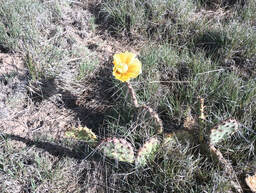 Lower to the ground, prickly pear cactus also sported their summer flowers. It's always struck me as strange that these flowers are a beautiful, translucent yellow, because the juice from a prickly pear is bright pink -- very similar to the color of cholla flowers. If you've never had prickly pear jelly, you're missing out! A couple of times, it seemed that the air was full of the buzzing of bees. I finally slowed down and tried to figure out where the buzzing was coming from. There were bees visiting the cholla and prickly pear blossoms, but I soon discovered that most of them were underfoot. These were ground dwelling bees!
Lower to the ground, prickly pear cactus also sported their summer flowers. It's always struck me as strange that these flowers are a beautiful, translucent yellow, because the juice from a prickly pear is bright pink -- very similar to the color of cholla flowers. If you've never had prickly pear jelly, you're missing out! A couple of times, it seemed that the air was full of the buzzing of bees. I finally slowed down and tried to figure out where the buzzing was coming from. There were bees visiting the cholla and prickly pear blossoms, but I soon discovered that most of them were underfoot. These were ground dwelling bees!  I hadn't ever known before that there was such a thing, but apparently there are hundreds of different kinds of bees that live in New Mexico, and many of them are ground dwellers. Click here to learn more about them. I don't know whether the ones I saw are digger bees, miner bees, or cactus bees, but it was a pleasure to see them.
I hadn't ever known before that there was such a thing, but apparently there are hundreds of different kinds of bees that live in New Mexico, and many of them are ground dwellers. Click here to learn more about them. I don't know whether the ones I saw are digger bees, miner bees, or cactus bees, but it was a pleasure to see them. The desert might look deserted, especially on a warm summer day, but it is still alive and full of beauty.
Published on July 03, 2024 23:00
June 26, 2024
The Beginning of World War I
 July 28 marks the 100th anniversary of the beginning of World War I.
July 28 marks the 100th anniversary of the beginning of World War I. Some historians refer to early twentieth century Europe as a militaristic powderkeg, ready to go off at the merest suggestion of a spark. European nations at that time were eager for war so that they could prove their superiority over other nations. They had growing militaries and had joined together to form opposing military alliances, pledging to support their partner nations in case of war.
The spark that set off World War I was no mere suggestion. On June 28, 1914, a young Serbian patriot shot and killed Archduke Franz Ferdinand, the heir to the Austro-Hungarian Empire in the city of Sarajevo. One month later, Austria-Hungary declared war on Serbia. Within a month, each side’s allies had joined the fray and World War I was underway. The United States managed to stay out of the fight until three years into the war. On April 2, 1917, when President Woodrow Wilson finally requested the Congress to declare war on Germany, he gave two reasons why America should go to war.
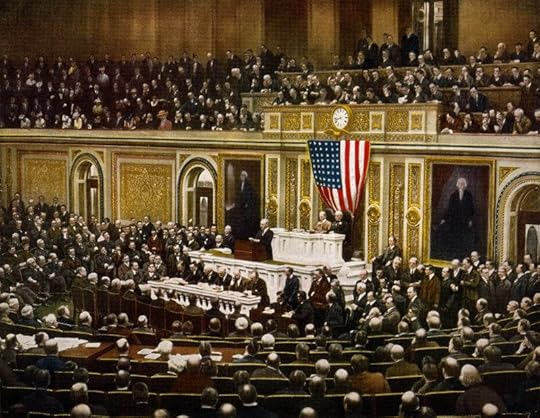 President Wilson asking Congress to declare war on Germany, April 2, 1917 public domain photo
President Wilson asking Congress to declare war on Germany, April 2, 1917 public domain photo
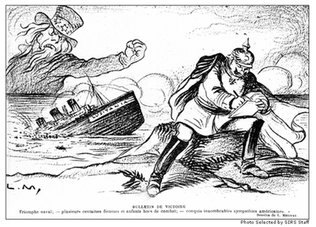 The first reason was that Germany had broken its earlier promise to suspend its unrestricted submarine warfare in the North Atlantic and the Mediterranean. The Hague Convention of 1907 prohibited sinking of merchant ships without warning. Ships had to be stopped and their crews and passengers placed in a safe place before the ship was sunk. The provision of a safe place for crews and passengers did not include lifeboats unless the ship was close to shore. Neutrals could only be sunk if they had been searched, and contraband had been found. However, Germans did not adhere to the rules of the Hague Convention. On May 7, 1915, one of its U-boats sank the Lusitania. a British ship that was carrying contraband. The passengers and crew had been given no warning of the attack and no opportunity to abandon ship or evacuate. 1,195 civilians were killed., including 123 Americans. The American steamer Housatonic was sunk by U-53 on February 3, 1917. Three weeks later, two American civilians died when the British liner Laconia was sunk. The sinking of other American ships, the Lyman M Law, the Algonquin, the City of Memphis, the Illinois, the Vigilancia and the Aztec, followed. It was clear that the Germans had no interest in holding to international law. Its attacks on Allied and neutral merchant and passenger ships were going to lead to the loss of more American lives and jeopardized American sea trade.
The first reason was that Germany had broken its earlier promise to suspend its unrestricted submarine warfare in the North Atlantic and the Mediterranean. The Hague Convention of 1907 prohibited sinking of merchant ships without warning. Ships had to be stopped and their crews and passengers placed in a safe place before the ship was sunk. The provision of a safe place for crews and passengers did not include lifeboats unless the ship was close to shore. Neutrals could only be sunk if they had been searched, and contraband had been found. However, Germans did not adhere to the rules of the Hague Convention. On May 7, 1915, one of its U-boats sank the Lusitania. a British ship that was carrying contraband. The passengers and crew had been given no warning of the attack and no opportunity to abandon ship or evacuate. 1,195 civilians were killed., including 123 Americans. The American steamer Housatonic was sunk by U-53 on February 3, 1917. Three weeks later, two American civilians died when the British liner Laconia was sunk. The sinking of other American ships, the Lyman M Law, the Algonquin, the City of Memphis, the Illinois, the Vigilancia and the Aztec, followed. It was clear that the Germans had no interest in holding to international law. Its attacks on Allied and neutral merchant and passenger ships were going to lead to the loss of more American lives and jeopardized American sea trade.
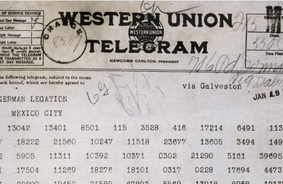 The second reason Wilson urged Congress to declare war on Germany was that Germany was encouraging Mexico to attack the U.S. On January 19, 1917, British naval intelligence intercepted a telegram sent by German Foreign Minister Arthur Zimmermann to the German Ambassador in Mexico. This telegram, known as the Zimmerman telegram, was written in code. When decoded, it showed that in exchange for supporting Germany, the Mexican Government would regain territory lost during the Mexican-American War. This meant that Texas, New Mexico, and Arizona would be returned to Mexico. Coming so soon after Pancho Villa’s raid on Columbus, New Mexico, the threat of war on the border seemed very real. Intelligence sources shared the Zimmerman telegram with President Wilson on February 24. The American press published the story a couple of days later. This, and the German’s use of unrestricted submarine warfare pushed U.S. public opinion to support entering the war.
The second reason Wilson urged Congress to declare war on Germany was that Germany was encouraging Mexico to attack the U.S. On January 19, 1917, British naval intelligence intercepted a telegram sent by German Foreign Minister Arthur Zimmermann to the German Ambassador in Mexico. This telegram, known as the Zimmerman telegram, was written in code. When decoded, it showed that in exchange for supporting Germany, the Mexican Government would regain territory lost during the Mexican-American War. This meant that Texas, New Mexico, and Arizona would be returned to Mexico. Coming so soon after Pancho Villa’s raid on Columbus, New Mexico, the threat of war on the border seemed very real. Intelligence sources shared the Zimmerman telegram with President Wilson on February 24. The American press published the story a couple of days later. This, and the German’s use of unrestricted submarine warfare pushed U.S. public opinion to support entering the war.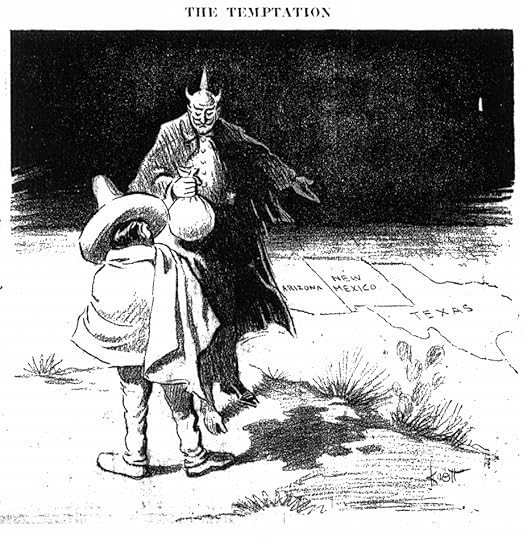 Four days after Wilson’s appearance before Congress, the U.S. declared war on Germany and declared themselves an "Associated Power" of the Allies. Within a year, our Army grew. While there were just 300,000 soldiers stationed in the U.S., by the end of the war in November 1918 there were around 2 million American soldiers in Europe alone. The United States of America had become a global power.
Four days after Wilson’s appearance before Congress, the U.S. declared war on Germany and declared themselves an "Associated Power" of the Allies. Within a year, our Army grew. While there were just 300,000 soldiers stationed in the U.S., by the end of the war in November 1918 there were around 2 million American soldiers in Europe alone. The United States of America had become a global power. Jennifer Bohnhoff is a former educator, and the writer of historical fiction for middle grade through adult readers. Her adult novel, A Blaze of Poppies, is set in the time of the Pancho Villa Raid and follows two New Mexican characters into the trenches of World War I.
Jennifer Bohnhoff is a former educator, and the writer of historical fiction for middle grade through adult readers. Her adult novel, A Blaze of Poppies, is set in the time of the Pancho Villa Raid and follows two New Mexican characters into the trenches of World War I.
Published on June 26, 2024 23:00
June 12, 2024
Mamie Phipps Clark: Champion for Children
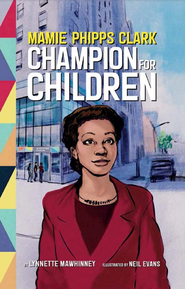 When Mamie Phipps Clarks was just four years old, she was frightened to hear of the lynching of Gilbert Harris in her community of Hot Springs, Arkansas. Mamie realized that the world was not as open and caring as her family and close community. The injustice, discrimination, and unfair treatment that her community faced needed addressing. She began to ask herself what she could do to help Black children faced with such negativity.
When Mamie Phipps Clarks was just four years old, she was frightened to hear of the lynching of Gilbert Harris in her community of Hot Springs, Arkansas. Mamie realized that the world was not as open and caring as her family and close community. The injustice, discrimination, and unfair treatment that her community faced needed addressing. She began to ask herself what she could do to help Black children faced with such negativity. Mamie Phipps Clark: Champion for Children is a graphic novel that is part autobiography, part self-help activist awareness manual. in it, Lynnette Mawhinney tells the story of an extraordinary woman who, after being the
 first Black woman to graduate from Columbia University with a doctorate degree in psychology, began research on the development of self-image in Black children. Her conclusions, that racial segregations resulted in negative outcomes for Black childhood development, became pivotal in the fight to end segregation of U.S. schools. The fight wasn't easy: Clark had a hard time balancing her public and private life. Raising a family while developing a career and fighting a political system is hard work, and Mawhinney doesn't sugar coat the stress.
first Black woman to graduate from Columbia University with a doctorate degree in psychology, began research on the development of self-image in Black children. Her conclusions, that racial segregations resulted in negative outcomes for Black childhood development, became pivotal in the fight to end segregation of U.S. schools. The fight wasn't easy: Clark had a hard time balancing her public and private life. Raising a family while developing a career and fighting a political system is hard work, and Mawhinney doesn't sugar coat the stress. Neil Evans' illustrations are clear and compelling and make this graphic novel an interesting read.
Mamie Phipps Clark, Champion for Children goes beyond just being a biography of an inspiring woman. It gives middle-grade readers a lot to think about regarding race, identity, and advocacy. Each chapter ends with a brief history lesson that helps set the scene for Clark's life, and then a section called Try This that gives readers a chance to extend the lessons of the past into today through thought-provoking activities. A timeline and glossary at the end of the book will help readers understand our nation's struggle for equality and be able to voice their concerns as they carry on Mamie’s legacy and become champions for themselves and others in their community.
 The author of this book is the no less impressive and inspiring Lynnette Mawhinney, an award-winning writer, creator, and long time educator who taught high school English in Philadelphia before she transitioned into teacher education. A Professor of Urban Education and Senior Associate Dean for Strategic Academic initiatives at Rutgers University-Newark, she had conducted teacher trainings throughout the world, including Vietnam, South Africa, Bahrain, and Egypt. She is the author of five academic books and books for children, and is the founder and President of Gaen Knowledge, a consultancy firm that performs equity audits. I am grateful that Magination Press provided me with an ARC of this hard cover graphic novel, which is the third book in the American Psychological Association's Extraordinary Women in Psychology series. If you'd like me to send you my copy, please comment below.
The author of this book is the no less impressive and inspiring Lynnette Mawhinney, an award-winning writer, creator, and long time educator who taught high school English in Philadelphia before she transitioned into teacher education. A Professor of Urban Education and Senior Associate Dean for Strategic Academic initiatives at Rutgers University-Newark, she had conducted teacher trainings throughout the world, including Vietnam, South Africa, Bahrain, and Egypt. She is the author of five academic books and books for children, and is the founder and President of Gaen Knowledge, a consultancy firm that performs equity audits. I am grateful that Magination Press provided me with an ARC of this hard cover graphic novel, which is the third book in the American Psychological Association's Extraordinary Women in Psychology series. If you'd like me to send you my copy, please comment below.
 Jennifer Bohnhoff is a former educator who now concentrates on writing historical and contemporary fiction for middle grade through adult readers. Her next book, The Famished Country, is book three in Rebels Along the Rio Grande, a trilogy of middle grade novels set in New Mexico during the Civil War, and is due out from Kinkajou Press in October 2024.
Jennifer Bohnhoff is a former educator who now concentrates on writing historical and contemporary fiction for middle grade through adult readers. Her next book, The Famished Country, is book three in Rebels Along the Rio Grande, a trilogy of middle grade novels set in New Mexico during the Civil War, and is due out from Kinkajou Press in October 2024.
Published on June 12, 2024 23:00
June 5, 2024
Recognizing the 80th Anniversary of D-Day
Eighty years ago, the Allied Forces began the largest amphibious military invasion in human history. On June 6, 1944, more than 130 battleships, cruisers, and destroyers bombarded the French coast while 277 minesweepers cleared the water. Behind them, about 7,000 vessels, packed with nearly 200,000 soldiers from eight Allied nations, crossed the channel, ready to storm the beaches of Normandy. Overhead, over 1,200 aircraft delivered paratroopers behind enemy lines. It was feat the size and scope of had never been seen. It still remains singularly large and impressive today.
More than 2 million Allied personnel took part in Operation Overlord, the code name for the Battle of Normandy that began with the D-Day invasion and continued on through August. During the Trident Conference in Washington in May 1943, the Allies appointed U.S. General Dwight D. Eisenhower to command the Expeditionary Force and put British General Bernard Montgomery in charge of the 21st Army Group, which comprised all the land forces. The allies chose the Normandy coast for the landings, assigning Americans the sectors codenamed Utah and Omaha, while the British were to land at Sword and Gold, and the Canadians were to land at Juno.
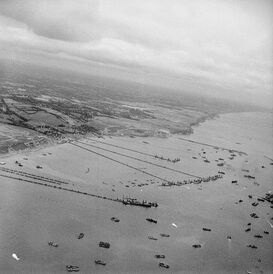 By Harrison (Sgt), No 5 Army Film & Photographic Unit - http://media.iwm.org.uk/iwm/mediaLib/... This photograph BU 1024 comes from the collections of the Imperial War Museums., Public Domain The Allies needed to develop special technology to meet the conditions expected on the Normandy beachhead. They invented artificial ports, called Mulberry harbors, to provide deep water jetties and places where the invasion force could download reinforcements and supplies before major French ports were recaptured from the Germans and their damage repaired. Two Mulberry harbors were created: Mulberry "A" at Omaha Beach and Mulberry "B" at Gold Beach. The harbor at Omaha Beach was damaged by a violent storm before it was ever completed, and the Americans abandoned it, landing their men and material over the open beaches. However, the harbor at Gold Beach was a great success. Over 2.5 million men, 500,000 vehicles, and 4 million tons of supplies used Mulberry “B” during the 10 months it was in use.
By Harrison (Sgt), No 5 Army Film & Photographic Unit - http://media.iwm.org.uk/iwm/mediaLib/... This photograph BU 1024 comes from the collections of the Imperial War Museums., Public Domain The Allies needed to develop special technology to meet the conditions expected on the Normandy beachhead. They invented artificial ports, called Mulberry harbors, to provide deep water jetties and places where the invasion force could download reinforcements and supplies before major French ports were recaptured from the Germans and their damage repaired. Two Mulberry harbors were created: Mulberry "A" at Omaha Beach and Mulberry "B" at Gold Beach. The harbor at Omaha Beach was damaged by a violent storm before it was ever completed, and the Americans abandoned it, landing their men and material over the open beaches. However, the harbor at Gold Beach was a great success. Over 2.5 million men, 500,000 vehicles, and 4 million tons of supplies used Mulberry “B” during the 10 months it was in use.
Another technology developed for the D-Day landings were the Hobart's Funnies,a group of specialized armoured fighting vehicles based on the British Churchill tank, and American M4 Sherman, but equipped with bulldozers, flamethrowers, demolition charges, reels of canvas that could be unrolled to form paths for other vehicles, assault bridges, ramps, and other modifications to help take the beach and destroy German fortifications. Hobart's Funnies were named for Major-General Sir Percy Cleghorn Stanley Hobart, a British Engineer.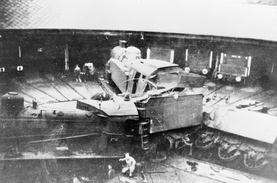 Train damaged by resistance sabateurs https://www.iwm.org.uk/collections/it... All the while that Allied forces were developing their plans and technologies, Resistance groups were active throughout German-occupied France. Their contributions to the invasion of Normandy included the gathering of intelligence on German defences and the carrying out of sabotage missions to disrupt the German war effort, including the destruction of rail lines and train engines and the cutting of telegraph and telephone lines. Because there were many different Resistance organizations that operated independently and often had different goals, coordinating them with the Allied forces was difficult. Many, however, listened to the secret messages from the Free French that were broadcast over the BBC. On the first of May, and again on June 1, such messages warned that the invasion would be soon and encouraged Allied secret agents and resistance fighters to carry out their acts of sabotage as soon as possible. Although the Allies failed to accomplish their objectives for the first day of the invasion, they were able to gain a tenuous foothold on the land that Germany had held since taking France. They captured the port at Cherbourg on June 26, and the city of Caen on July 21. By August 25, the Allies had liberated Paris. Five days later, the Germans retreated east across the Seine marking the close of Operation Overlord and the beginning of the end for the Nazi regime.
Train damaged by resistance sabateurs https://www.iwm.org.uk/collections/it... All the while that Allied forces were developing their plans and technologies, Resistance groups were active throughout German-occupied France. Their contributions to the invasion of Normandy included the gathering of intelligence on German defences and the carrying out of sabotage missions to disrupt the German war effort, including the destruction of rail lines and train engines and the cutting of telegraph and telephone lines. Because there were many different Resistance organizations that operated independently and often had different goals, coordinating them with the Allied forces was difficult. Many, however, listened to the secret messages from the Free French that were broadcast over the BBC. On the first of May, and again on June 1, such messages warned that the invasion would be soon and encouraged Allied secret agents and resistance fighters to carry out their acts of sabotage as soon as possible. Although the Allies failed to accomplish their objectives for the first day of the invasion, they were able to gain a tenuous foothold on the land that Germany had held since taking France. They captured the port at Cherbourg on June 26, and the city of Caen on July 21. By August 25, the Allies had liberated Paris. Five days later, the Germans retreated east across the Seine marking the close of Operation Overlord and the beginning of the end for the Nazi regime.
Few of the veterans of D-Day are still alive, but we remember them and honor them for their bravery.
 Code: Elephants on the Moon is author Jennifer Bohnhoff's novel about Eponine Lambaol, a girl who senses that strange things are going on in her Nazi-held village in Normandy. As D-Day nears, she joins with others to resist the Germans and prepare for the Allied invasion. Written for middle school readers, adults have also found this an informative and entertaining read.
Code: Elephants on the Moon is author Jennifer Bohnhoff's novel about Eponine Lambaol, a girl who senses that strange things are going on in her Nazi-held village in Normandy. As D-Day nears, she joins with others to resist the Germans and prepare for the Allied invasion. Written for middle school readers, adults have also found this an informative and entertaining read.
More than 2 million Allied personnel took part in Operation Overlord, the code name for the Battle of Normandy that began with the D-Day invasion and continued on through August. During the Trident Conference in Washington in May 1943, the Allies appointed U.S. General Dwight D. Eisenhower to command the Expeditionary Force and put British General Bernard Montgomery in charge of the 21st Army Group, which comprised all the land forces. The allies chose the Normandy coast for the landings, assigning Americans the sectors codenamed Utah and Omaha, while the British were to land at Sword and Gold, and the Canadians were to land at Juno.
 By Harrison (Sgt), No 5 Army Film & Photographic Unit - http://media.iwm.org.uk/iwm/mediaLib/... This photograph BU 1024 comes from the collections of the Imperial War Museums., Public Domain The Allies needed to develop special technology to meet the conditions expected on the Normandy beachhead. They invented artificial ports, called Mulberry harbors, to provide deep water jetties and places where the invasion force could download reinforcements and supplies before major French ports were recaptured from the Germans and their damage repaired. Two Mulberry harbors were created: Mulberry "A" at Omaha Beach and Mulberry "B" at Gold Beach. The harbor at Omaha Beach was damaged by a violent storm before it was ever completed, and the Americans abandoned it, landing their men and material over the open beaches. However, the harbor at Gold Beach was a great success. Over 2.5 million men, 500,000 vehicles, and 4 million tons of supplies used Mulberry “B” during the 10 months it was in use.
By Harrison (Sgt), No 5 Army Film & Photographic Unit - http://media.iwm.org.uk/iwm/mediaLib/... This photograph BU 1024 comes from the collections of the Imperial War Museums., Public Domain The Allies needed to develop special technology to meet the conditions expected on the Normandy beachhead. They invented artificial ports, called Mulberry harbors, to provide deep water jetties and places where the invasion force could download reinforcements and supplies before major French ports were recaptured from the Germans and their damage repaired. Two Mulberry harbors were created: Mulberry "A" at Omaha Beach and Mulberry "B" at Gold Beach. The harbor at Omaha Beach was damaged by a violent storm before it was ever completed, and the Americans abandoned it, landing their men and material over the open beaches. However, the harbor at Gold Beach was a great success. Over 2.5 million men, 500,000 vehicles, and 4 million tons of supplies used Mulberry “B” during the 10 months it was in use. Another technology developed for the D-Day landings were the Hobart's Funnies,a group of specialized armoured fighting vehicles based on the British Churchill tank, and American M4 Sherman, but equipped with bulldozers, flamethrowers, demolition charges, reels of canvas that could be unrolled to form paths for other vehicles, assault bridges, ramps, and other modifications to help take the beach and destroy German fortifications. Hobart's Funnies were named for Major-General Sir Percy Cleghorn Stanley Hobart, a British Engineer.
 Train damaged by resistance sabateurs https://www.iwm.org.uk/collections/it... All the while that Allied forces were developing their plans and technologies, Resistance groups were active throughout German-occupied France. Their contributions to the invasion of Normandy included the gathering of intelligence on German defences and the carrying out of sabotage missions to disrupt the German war effort, including the destruction of rail lines and train engines and the cutting of telegraph and telephone lines. Because there were many different Resistance organizations that operated independently and often had different goals, coordinating them with the Allied forces was difficult. Many, however, listened to the secret messages from the Free French that were broadcast over the BBC. On the first of May, and again on June 1, such messages warned that the invasion would be soon and encouraged Allied secret agents and resistance fighters to carry out their acts of sabotage as soon as possible. Although the Allies failed to accomplish their objectives for the first day of the invasion, they were able to gain a tenuous foothold on the land that Germany had held since taking France. They captured the port at Cherbourg on June 26, and the city of Caen on July 21. By August 25, the Allies had liberated Paris. Five days later, the Germans retreated east across the Seine marking the close of Operation Overlord and the beginning of the end for the Nazi regime.
Train damaged by resistance sabateurs https://www.iwm.org.uk/collections/it... All the while that Allied forces were developing their plans and technologies, Resistance groups were active throughout German-occupied France. Their contributions to the invasion of Normandy included the gathering of intelligence on German defences and the carrying out of sabotage missions to disrupt the German war effort, including the destruction of rail lines and train engines and the cutting of telegraph and telephone lines. Because there were many different Resistance organizations that operated independently and often had different goals, coordinating them with the Allied forces was difficult. Many, however, listened to the secret messages from the Free French that were broadcast over the BBC. On the first of May, and again on June 1, such messages warned that the invasion would be soon and encouraged Allied secret agents and resistance fighters to carry out their acts of sabotage as soon as possible. Although the Allies failed to accomplish their objectives for the first day of the invasion, they were able to gain a tenuous foothold on the land that Germany had held since taking France. They captured the port at Cherbourg on June 26, and the city of Caen on July 21. By August 25, the Allies had liberated Paris. Five days later, the Germans retreated east across the Seine marking the close of Operation Overlord and the beginning of the end for the Nazi regime. Few of the veterans of D-Day are still alive, but we remember them and honor them for their bravery.
 Code: Elephants on the Moon is author Jennifer Bohnhoff's novel about Eponine Lambaol, a girl who senses that strange things are going on in her Nazi-held village in Normandy. As D-Day nears, she joins with others to resist the Germans and prepare for the Allied invasion. Written for middle school readers, adults have also found this an informative and entertaining read.
Code: Elephants on the Moon is author Jennifer Bohnhoff's novel about Eponine Lambaol, a girl who senses that strange things are going on in her Nazi-held village in Normandy. As D-Day nears, she joins with others to resist the Germans and prepare for the Allied invasion. Written for middle school readers, adults have also found this an informative and entertaining read.
Published on June 05, 2024 23:00



